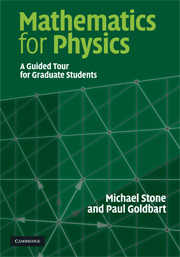Book contents
- Frontmatter
- Contents
- Preface
- Acknowledgments
- 1 Calculus of variations
- 2 Function spaces
- 3 Linear ordinary differential equations
- 4 Linear differential operators
- 5 Green functions
- 6 Partial differential equations
- 7 The mathematics of real waves
- 8 Special functions
- 9 Integral equations
- 10 Vectors and tensors
- 11 Differential calculus on manifolds
- 12 Integration on manifolds
- 13 An introduction to differential topology
- 14 Groups and group representations
- 15 Lie groups
- 16 The geometry of fibre bundles
- 17 Complex analysis
- 18 Applications of complex variables
- 19 Special functions and complex variables
- A Linear algebra review
- B Fourier series and integrals
- References
- Index
16 - The geometry of fibre bundles
Published online by Cambridge University Press: 05 June 2012
- Frontmatter
- Contents
- Preface
- Acknowledgments
- 1 Calculus of variations
- 2 Function spaces
- 3 Linear ordinary differential equations
- 4 Linear differential operators
- 5 Green functions
- 6 Partial differential equations
- 7 The mathematics of real waves
- 8 Special functions
- 9 Integral equations
- 10 Vectors and tensors
- 11 Differential calculus on manifolds
- 12 Integration on manifolds
- 13 An introduction to differential topology
- 14 Groups and group representations
- 15 Lie groups
- 16 The geometry of fibre bundles
- 17 Complex analysis
- 18 Applications of complex variables
- 19 Special functions and complex variables
- A Linear algebra review
- B Fourier series and integrals
- References
- Index
Summary
In earlier chapters we have used the language of bundles and connections, but in a relatively casual manner. We deferred proper mathematical definitions until now, because, for the applications we meet in physics, it helps to first have acquired an understanding of the geometry of Lie groups.
Fibre bundles
We begin with a formal definition of a bundle and then illustrate the definition with examples from quantum mechanics. These allow us to appreciate the physics that the definition is designed to capture.
Definitions
A smooth bundle comprises three ingredients: E, π and M, where E and M are manifolds, and π : E → M is a smooth surjective (onto) map. The manifold E is the total space, M is the base space and π is the projection map. The inverse image π-1(x) of a point in M (i.e. the set of points in E that map to x in M) is the fibre over x.
We usually require that all fibres be diffeomorphic to some fixed manifold F. The bundle is then a fibre bundle, and F is “the fibre” of the bundle. In a similar vein, we sometimes also refer to the total space E as “the bundle”. Examples of possible fibres are vector spaces (in which case we have a vector bundle), spheres (in which case we have a sphere bundle) and Lie groups. When the fibre is a Lie group we speak of a principal bundle. A principal bundle can be thought of as the parent of various associated bundles, which are constructed by allowing the Lie group to act on a fibre. A bundle whose fibre is a one-dimensional vector space is called a line bundle.
- Type
- Chapter
- Information
- Mathematics for PhysicsA Guided Tour for Graduate Students, pp. 576 - 605Publisher: Cambridge University PressPrint publication year: 2009



